YAMAHA TDR 125 2001 Owner's Guide
Manufacturer: YAMAHA, Model Year: 2001, Model line: TDR 125, Model: YAMAHA TDR 125 2001Pages: 94, PDF Size: 5.07 MB
Page 31 of 94

4-3
NOTE:
Pre-operation checks should be made each time the motorcycle is used. Such an inspection can be accomplished in a
very short time; and the added safety it assures is more than worth the time involved.
EWA00033
wIf any item in the Pre-operation check list is not working properly, have it inspected and repaired before operat-
ing the motorcycle.PRE-OPERATION CHECKS
1
2
34
5
6
7
8
9
Chassis fasteners¥Make sure that all nuts, bolts and screws are properly tightened.
¥Tighten if necessary.Ñ
Instruments, lights,
signals and switches¥Check operation.
¥Correct if necessary.3-2Ð3-6
Sidestand switch¥Check operation of ignition circuit cut-off system.
¥If system is defective, have Yamaha dealer check vehicle.3-15Ð3-17 ITEMCHECKSPAGE
5AE-9-E4 (ENG) 8/30/00 5:04 PM Page 30
Page 32 of 94

5-1
EAU00373
w8Become thoroughly familiar
with all operating controls and
their functions before riding.
Consult a Yamaha dealer
regarding any control or func-
tion that you do not thorough-
ly understand.
8Never start the engine or oper-
ate it in a closed area for any
length of time. Exhaust fumes
are poisonous, and inhaling
them can cause loss of con-
sciousness and death within a
short time. Always make sure
that there is adequate ventila-
tion.
8Before starting out, make sure
that the sidestand is up. If the
sidestand is not raised com-
pletely, it could contact the
ground and distract the opera-
tor, resulting in a possible loss
of control.
EAU00381
Starting a cold engineIn order for the ignition circuit cut-off
system to enable starting, one of the
following conditions must be met:
8The transmission is in the neutral
position.
8The transmission is in gear with
the clutch lever pulled and the
sidestand up.
EW000054
w8Before starting the engine,
check the function of the igni-
tion circuit cut-off system
according to the procedure
described on page 3-17.
8Never ride with the sidestand
down.1.Turn the fuel cock lever to ÒONÓ.
2.Turn the key to ÒONÓ and make
sure that the engine stop switch
is set to Ò#Ó.3.Shift the transmission into the
neutral position.
NOTE:
When the transmission is in the neu-
tral position, the neutral indicator light
should be on, otherwise have a
Yamaha dealer check the electrical
circuit.4.Turn the starter (choke) on and
completely close the throttle.
(See page 3-12 for starter
(choke) operation.)
5.Start the engine by pushing the
start switch.NOTE:
If the engine fails to start, release the
start switch, wait a few seconds, and
then try again. Each starting attempt
should be as short as possible to pre-
serve the battery. Do not crank the
engine more than 10 seconds on any
one attempt.
EAU00372
OPERATION AND IMPORTANT RIDING POINTS
1
2
3
45
6
7
8
9
5AE-9-E4 (ENG) 8/30/00 5:04 PM Page 31
Page 33 of 94
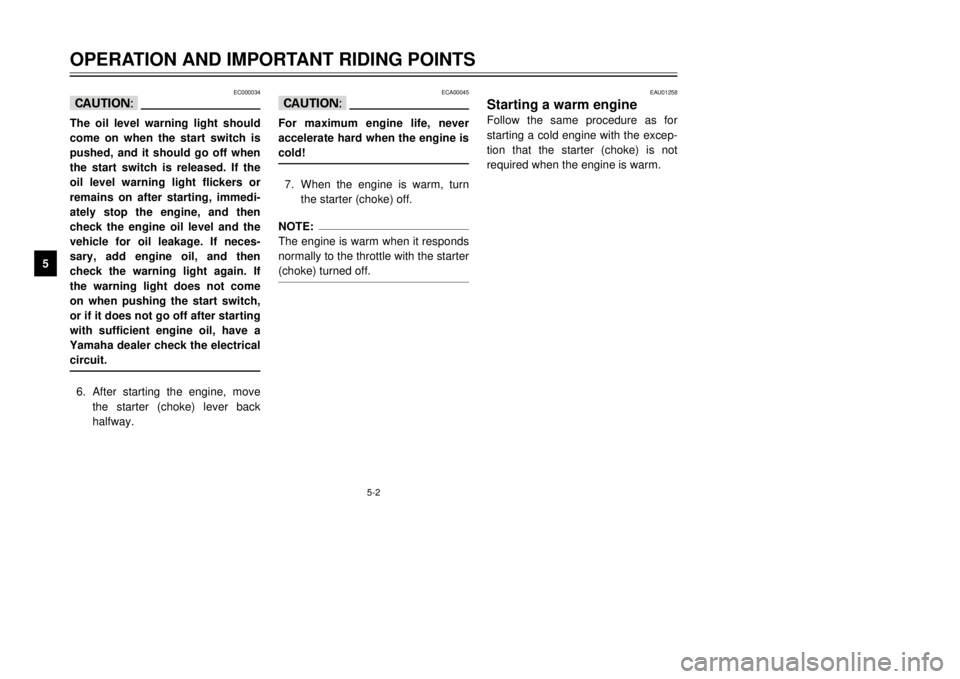
5-2
EC000034
cCThe oil level warning light should
come on when the start switch is
pushed, and it should go off when
the start switch is released. If the
oil level warning light flickers or
remains on after starting, immedi-
ately stop the engine, and then
check the engine oil level and the
vehicle for oil leakage. If neces-
sary, add engine oil, and then
check the warning light again. If
the warning light does not come
on when pushing the start switch,
or if it does not go off after starting
with sufficient engine oil, have a
Yamaha dealer check the electrical
circuit.6.After starting the engine, move
the starter (choke) lever back
halfway.
ECA00045
cCFor maximum engine life, never
accelerate hard when the engine is
cold!7.When the engine is warm, turn
the starter (choke) off.NOTE:
The engine is warm when it responds
normally to the throttle with the starter
(choke) turned off.
EAU01258
Starting a warm engineFollow the same procedure as for
starting a cold engine with the excep-
tion that the starter (choke) is not
required when the engine is warm.
OPERATION AND IMPORTANT RIDING POINTS
1
2
3
45
6
7
8
95AE-9-E4 (ENG) 8/30/00 5:04 PM Page 32
Page 34 of 94
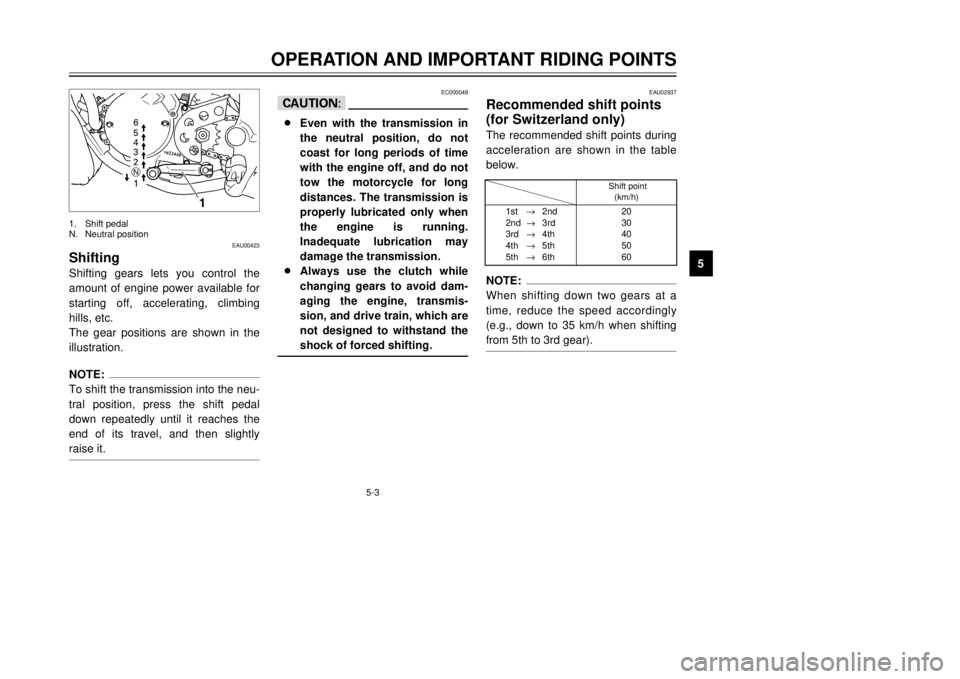
5-3
EAU00423
ShiftingShifting gears lets you control the
amount of engine power available for
starting off, accelerating, climbing
hills, etc.
The gear positions are shown in the
illustration.NOTE:
To shift the transmission into the neu-
tral position, press the shift pedal
down repeatedly until it reaches the
end of its travel, and then slightly
raise it.
EC000048
cC8Even with the transmission in
the neutral position, do not
coast for long periods of time
with the engine off, and do not
tow the motorcycle for long
distances. The transmission is
properly lubricated only when
the engine is running.
Inadequate lubrication may
damage the transmission.
8Always use the clutch while
changing gears to avoid dam-
aging the engine, transmis-
sion, and drive train, which are
not designed to withstand the
shock of forced shifting.
OPERATION AND IMPORTANT RIDING POINTS
1
2
3
45
6
7
8
9
6
5
4
3
2
1 N
1
1.Shift pedal
N.Neutral position
EAU02937
Recommended shift points
(for Switzerland only)The recommended shift points during
acceleration are shown in the table
below.NOTE:
When shifting down two gears at a
time, reduce the speed accordingly
(e.g., down to 35 km/h when shifting
from 5th to 3rd gear).
Shift point
(km/h)
1st®2nd
2nd®3rd
3rd®4th
4th®5th
5th®6th20
30
40
50
60
5AE-9-E4 (ENG) 8/30/00 5:04 PM Page 33
Page 35 of 94
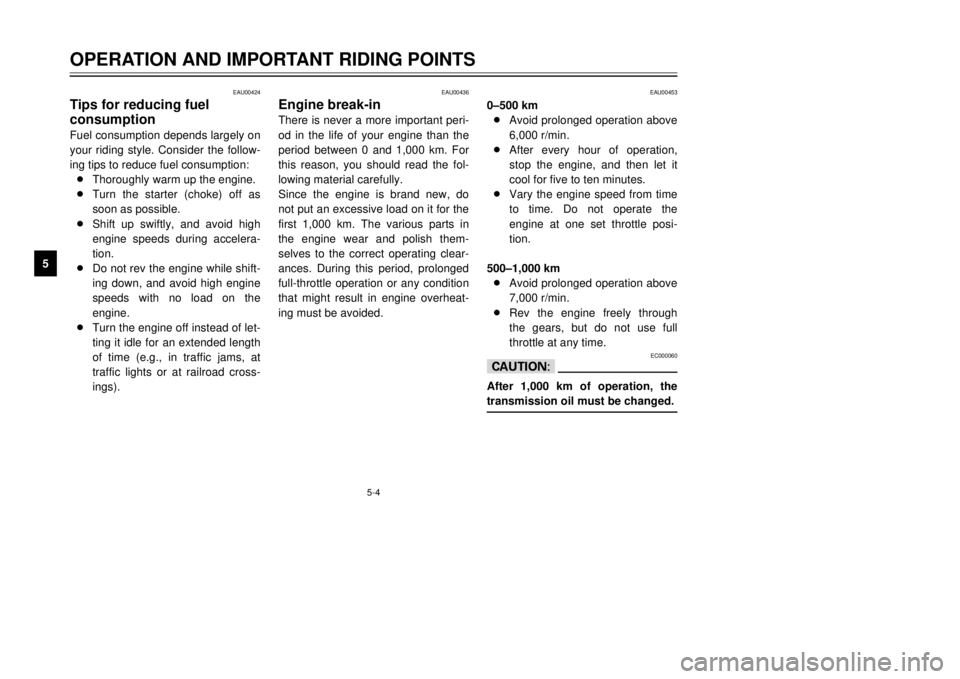
EAU00453
0Ð500 km
8Avoid prolonged operation above
6,000 r/min.
8After every hour of operation,
stop the engine, and then let it
cool for five to ten minutes.
8Vary the engine speed from time
to time. Do not operate the
engine at one set throttle posi-
tion.
500Ð1,000 km
8Avoid prolonged operation above
7,000 r/min.
8Rev the engine freely through
the gears, but do not use full
throttle at any time.
EC000060
cCAfter 1,000 km of operation, the
transmission oil must be changed.
5-4
EAU00424
Tips for reducing fuel
consumptionFuel consumption depends largely on
your riding style. Consider the follow-
ing tips to reduce fuel consumption:
8Thoroughly warm up the engine.
8Turn the starter (choke) off as
soon as possible.
8Shift up swiftly, and avoid high
engine speeds during accelera-
tion.
8Do not rev the engine while shift-
ing down, and avoid high engine
speeds with no load on the
engine.
8Turn the engine off instead of let-
ting it idle for an extended length
of time (e.g., in traffic jams, at
traffic lights or at railroad cross-
ings).
EAU00436
Engine break-inThere is never a more important peri-
od in the life of your engine than the
period between 0 and 1,000 km. For
this reason, you should read the fol-
lowing material carefully.
Since the engine is brand new, do
not put an excessive load on it for the
first 1,000 km. The various parts in
the engine wear and polish them-
selves to the correct operating clear-
ances. During this period, prolonged
full-throttle operation or any condition
that might result in engine overheat-
ing must be avoided.
OPERATION AND IMPORTANT RIDING POINTS
1
2
3
45
6
7
8
95AE-9-E4 (ENG) 8/30/00 5:04 PM Page 34
Page 36 of 94
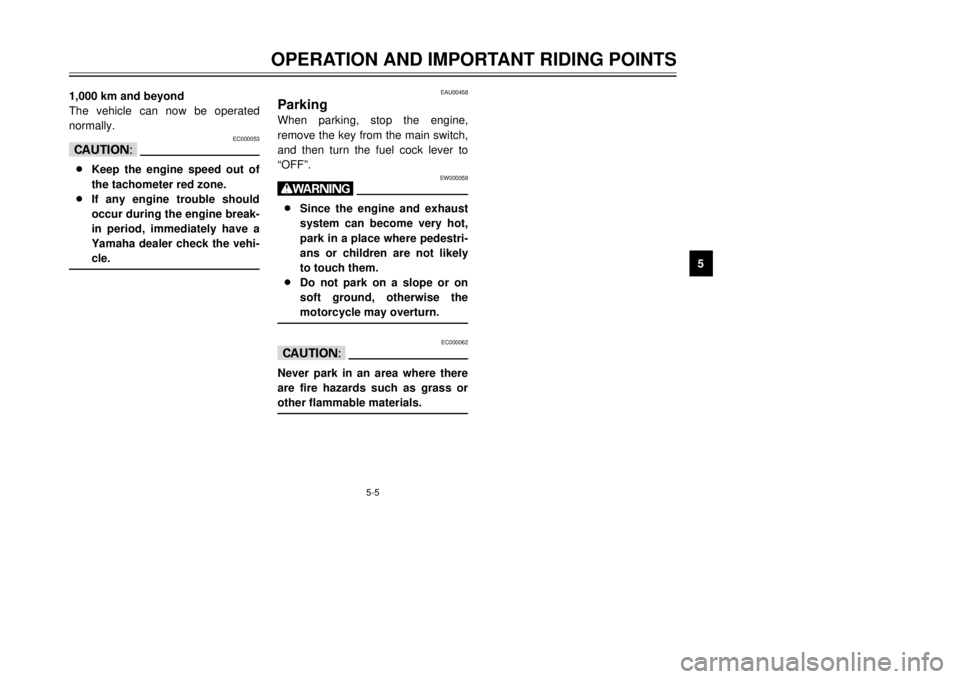
5-5
1,000 km and beyond
The vehicle can now be operated
normally.
EC000053
cC8Keep the engine speed out of
the tachometer red zone.
8If any engine trouble should
occur during the engine break-
in period, immediately have a
Yamaha dealer check the vehi-
cle.
EAU00458
ParkingWhen parking, stop the engine,
remove the key from the main switch,
and then turn the fuel cock lever to
ÒOFFÓ.
EW000058
w8Since the engine and exhaust
system can become very hot,
park in a place where pedestri-
ans or children are not likely
to touch them.
8Do not park on a slope or on
soft ground, otherwise the
motorcycle may overturn.
EC000062
cCNever park in an area where there
are fire hazards such as grass or
other flammable materials.OPERATION AND IMPORTANT RIDING POINTS
1
2
3
45
6
7
8
9
5AE-9-E4 (ENG) 8/30/00 5:04 PM Page 35
Page 37 of 94
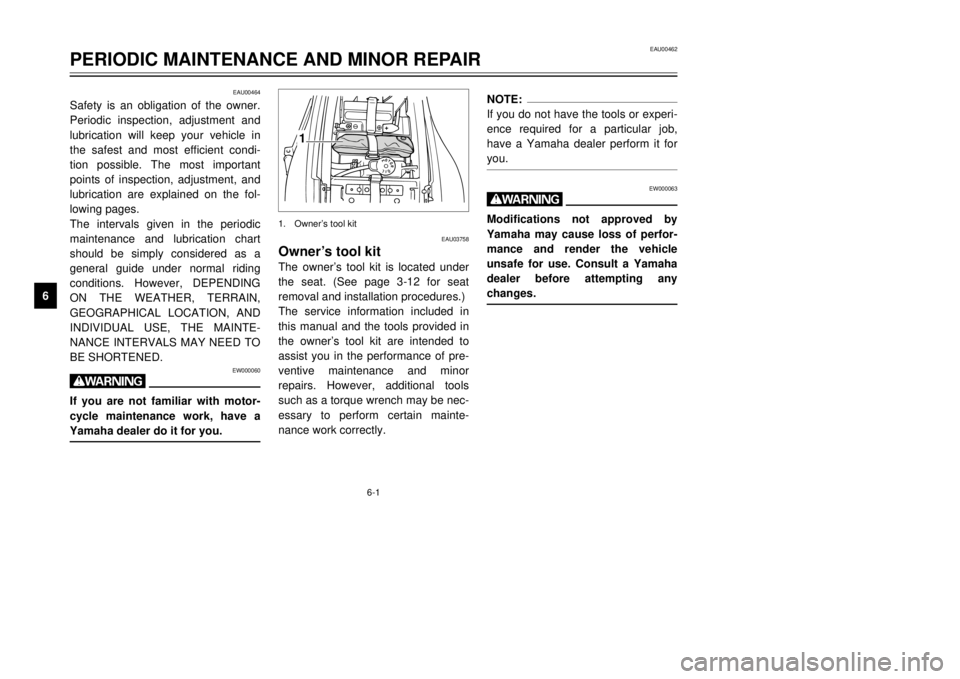
NOTE:
If you do not have the tools or experi-
ence required for a particular job,
have a Yamaha dealer perform it for
you.
EW000063
wModifications not approved by
Yamaha may cause loss of perfor-
mance and render the vehicle
unsafe for use. Consult a Yamaha
dealer before attempting any
changes.
6-1
EAU00464
Safety is an obligation of the owner.
Periodic inspection, adjustment and
lubrication will keep your vehicle in
the safest and most efficient condi-
tion possible. The most important
points of inspection, adjustment, and
lubrication are explained on the fol-
lowing pages.
The intervals given in the periodic
maintenance and lubrication chart
should be simply considered as a
general guide under normal riding
conditions. However, DEPENDING
ON THE WEATHER, TERRAIN,
GEOGRAPHICAL LOCATION, AND
INDIVIDUAL USE, THE MAINTE-
NANCE INTERVALS MAY NEED TO
BE SHORTENED.
EW000060
wIf you are not familiar with motor-
cycle maintenance work, have a
Yamaha dealer do it for you.
EAU00462
PERIODIC MAINTENANCE AND MINOR REPAIR
1
2
3
4
56
7
8
9
1
EAU03758
OwnerÕs tool kitThe ownerÕs tool kit is located under
the seat. (See page 3-12 for seat
removal and installation procedures.)
The service information included in
this manual and the tools provided in
the ownerÕs tool kit are intended to
assist you in the performance of pre-
ventive maintenance and minor
repairs. However, additional tools
such as a torque wrench may be nec-
essary to perform certain mainte-
nance work correctly.1.OwnerÕs tool kit
5AE-9-E4 (ENG) 8/30/00 5:04 PM Page 36
Page 38 of 94

6-2
PERIODIC MAINTENANCE AND MINOR REPAIR
1
2
3
4
56
7
8
9
EAU03686
Periodic maintenance and lubrication chart
NOTE:
8The annual checks must be performed every year, except if a kilometer-based maintenance is performed instead.
8From 30,000 km, repeat the maintenance intervals starting from 6,000 km.
8Items marked with an asterisk should be performed by a Yamaha dealer as they require special tools, data and
technical skills.NO.ITEMCHECK OR MAINTENANCE JOBODOMETER READING (´1,000 km)
ANNUAL
CHECK
16121824
1
*Fuel line¥Check fuel hoses for cracks or damage.ÖÖÖÖÖ
2Spark plug¥Replace.ÖÖÖÖÖ
3Air filter element¥Clean.ÖÖ
¥Replace.ÖÖ
4Clutch¥Check operation.
¥Adjust.ÖÖÖÖÖ
5*Front brake¥Check operation, fluid level and vehicle for fluid leakage.
(See NOTE on page 6-4.)ÖÖÖÖÖÖ
¥Replace brake pads.Whenever worn to the limit
6*Rear brake¥Check operation, fluid level and vehicle for fluid leakage.
(See NOTE on page 6-4.)ÖÖÖÖÖÖ
¥Replace brake pads.Whenever worn to the limit
7*Brake hoses¥Check for cracks or damage.ÖÖÖÖÖ
¥Replace. (See NOTE on page 6-4.)Every 4 years
8*Wheels¥Check runout and for damage.ÖÖÖÖ
5AE-9-E4 (ENG) 8/30/00 5:04 PM Page 37
Page 39 of 94

6-3
PERIODIC MAINTENANCE AND MINOR REPAIR
1
2
3
4
56
7
8
9
9
*Tires¥Check tread depth and for damage.
¥Replace if necessary.
¥Check air pressure.
¥Correct if necessary.ÖÖÖÖ
10*Wheel bearings¥Check bearing for looseness or damage.ÖÖÖÖ
11*Swingarm¥Check swingarm pivoting point for play.ÖÖÖÖ
¥Lubricate with lithium-soap-based grease.Every 24,000km
12Drive chain¥Check chain slack.
¥Make sure that the rear wheel is properly aligned.
¥Clean and lubricate.Every 1,000 km and after washing the motorcycle
or riding in the rain.
13*Steering bearings¥Check bearing play and steering for roughness.ÖÖÖÖÖ
¥Lubricate with lithium-soap-based greaseEvery 24,000km
14*Chassis fasteners¥Make sure that all nuts, bolts and screws are properly tightened.ÖÖÖÖÖ
15Sidestand¥Check operation.
¥Lubricate.ÖÖÖÖÖ
16*Sidestand switch¥Check operation.ÖÖÖÖÖÖ
17*Front fork¥Check operation and for oil leakage.ÖÖÖÖ
18*Rear shock absorber
assembly¥Check operation and shock absorber for oil leakage.ÖÖÖÖ
¥Lubricate the pivoting points with molybdenum disulfide
grease.ÖÖ
19*Carburetor¥Check starter (choke) operation.
¥Adjust engine idling speed.ÖÖÖÖÖÖ NO.ITEMCHECK OR MAINTENANCE JOBODOMETER READING (´1,000 km)
ANNUAL
CHECK
16121824
5AE-9-E4 (ENG) 8/30/00 5:04 PM Page 38
Page 40 of 94

6-4
PERIODIC MAINTENANCE AND MINOR REPAIR
6
20
*Autolube pump¥Check operation.
¥Bleed if necessary.ÖÖÖÖ
21Transmission oil¥Check.ÖÖÖÖÖÖ
¥Change.ÖÖ
22*Cooling system¥Check coolant level and vehicle for coolant leakage.ÖÖÖÖÖ
¥Change.Every 3 years
23*Front and rear brake
switches¥Check operation.ÖÖÖÖÖÖ
24Moving parts and cables¥Lubricate.ÖÖÖÖÖ
25*Lights, signals and
switches¥Check operation.
¥Adjust headlight beam.ÖÖÖÖÖÖ NO.ITEMCHECK OR MAINTENANCE JOBODOMETER READING (´1,000 km)
ANNUAL
CHECK
16121824
EAU03541
NOTE:
8The air filter needs more frequent service if you are riding in unusually wet or dusty areas.
8Hydraulic brake service
9Regularly check and, if necessary, correct the brake fluid level.
9Every two years replace the internal components of the brake master cylinder and caliper, and change the brake
fluid.
9Replace the brake hoses every four years and if cracked or damaged.
5AE-9-E4 (ENG) 8/30/00 5:04 PM Page 39